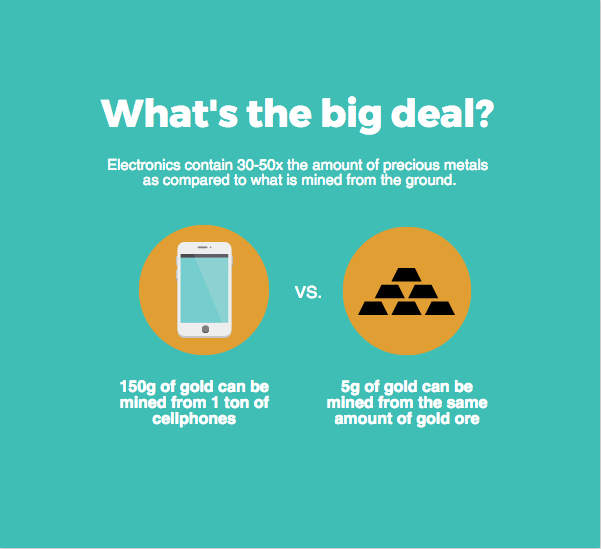What Is Urban Mining?
Urban mining is the practice of extracting valuable metals and materials from electronic waste. This seems pretty straightforward. In fact, if you’ve been following our blog at all or have done any reading on e-waste you know that electronics are created using all kinds of precious metals. And they're called
- precious for a reason,
- they're not easy to obtain,
- and highly valuable.
But why is this practice so important? Let's look at some of the facts.
To start off with, what is urban mining?
Urban mining is simply reclaiming e-waste products sent to landfills and the process of extracting raw materials from those devices. These can include iPhones, Android phones, MacBooks, tablets, etc.
Oftentimes e-waste is shipped overseas to developing countries, or unregulated countries, where unprotected and/or unregulated workers are extracting those valuable raw materials. We'll provide an example of this fact in a moment.
Even worse, e-waste is simply dumped in landfills where urban miners scavenge for materials that they can sell. Not to mention, many could profit from the data that is on devices...
If we look at cell phones alone, for example, the Environmental Protection Agency estimated that for every million units recycled, one could extract:
- 35 thousand pounds of copper
- 772 pounds of silver
- 75 pounds of gold
- 33 pounds of palladium

It's also reported that the annual production of electronic goods worldwide requires 320 tons of gold and 7,500 tons of silver.
Follow that up with the knowledge that 50 million tons of e-waste are generated globally each year.
Just to give you some perspective: 50,000,000 tons is about seven-and-a-half times as heavy as The Great Pyramid of Giza. When you consider the diminutive and ever-shrinking size of laptops, phones, and tablets, that number is heartbreaking.
Why Not Urban Mining?
I’m sure right now you’re thinking that e-waste recycling and urban mining make a lot of sense. Well, then why are only 15-20% of the world’s electronics recycled annually and why are less than 15% of all gold and silver recovered from these electronics?
What is going on?!
Well, a few things actually.
The Ethics of Urban Mining
There’s a lot of money to be made in the e-waste recycling industry and unfortunately, a lot of it is made by shipping e-waste from developed to developing nations. Companies choosing to skirt the regulations around how e-waste is processed means more money for them in the short term, but it also means catastrophic issues for those developing nations.
An example of this is the city of Guiyu, China, which is considered the e-waste capital of the world.
Believe it or not, it gets about 4,000 tons of electronic waste every hour. About 90% of its residents have some form of neurological damage, making it the city with the highest-ever recorded level of dioxins globally.
Which leads directly into our next point. Safe and secure urban mining requires proper facilities to retrieve precious metals. E-waste is too often managed incorrectly and the laundry list of toxic materials they contain wreaks havoc on both humans and the environment.
Why Not Burn E-Waste?
There's the option of burning the e-waste. After all, we've seen the hacker shows where they place the thumb drive into the microwave to fry it. So, just burn the device to get rid of data, and then it's hot enough to extract the precious metals, right?
Right?
Here's the problem. A study showed that this activity can cause severe air pollution, not only affecting the environment but also posing a serious health risk, like cardiovascular morbidity namely hypertension.
Did we mention it's illegal as well?
Urban Mining Can Save Us, If Done Properly
As you can see, without the proper systems in place and the regulations to ensure compliance by companies managing e-waste there can actually be a lot of problems with urban mining. That being said, we’re sure it’s obvious why it’s such an important step toward a more sustainable future.
For consumers, it means that you should take your devices to where they can be safely disposed of. Just make sure that you follow these guides when resetting your devices before disposal:
For businesses, we recommend an ironclad ITAD process. IT asset disposition (ITAD) is the disposal of obsolete or unwanted IT assets in a secure, safe and environmentally-responsible manner.
To help you manage multiple locations or departments within your organization, as well as the mass amount of devices required to keep your organization in operation, IT disposition mapping can make ITAD a seamless and efficient process.
Proper and compliant ITAD is critical for any organization, therefore it is best to begin with an industry expert who can guide you through the various regulations and internal requirements for disposition and e-waste.
With Greentec’s help, you can remain confident in the fact that your organization is not only a leader in security and sustainability, but is also able to capitalize on hidden value and strategically plan a full digital transformation.
Don't let your e-waste fall into the hands of unscrupulous urban miners. For more information on how Greentec urban mines sustainably with the proper facilities with vetted and protected staff, learn more about our services.
Is your ITAD vendor compliant?
Download our Compliance Checklist for ITAD Vendors, and know exactly what kind of security, environmental, and quality services your vendor should provide.

CASE STUDY
How the University of Waterloo & Greentec are leading the way in asset disposal
UW partnered with Greentec, whose tailored solutions ensured secure data destruction, environmental responsibility, and regulatory compliance, to collaboratively transform its IT asset disposal process.






